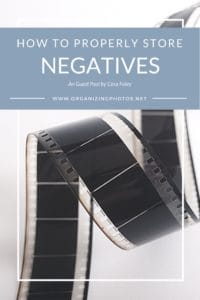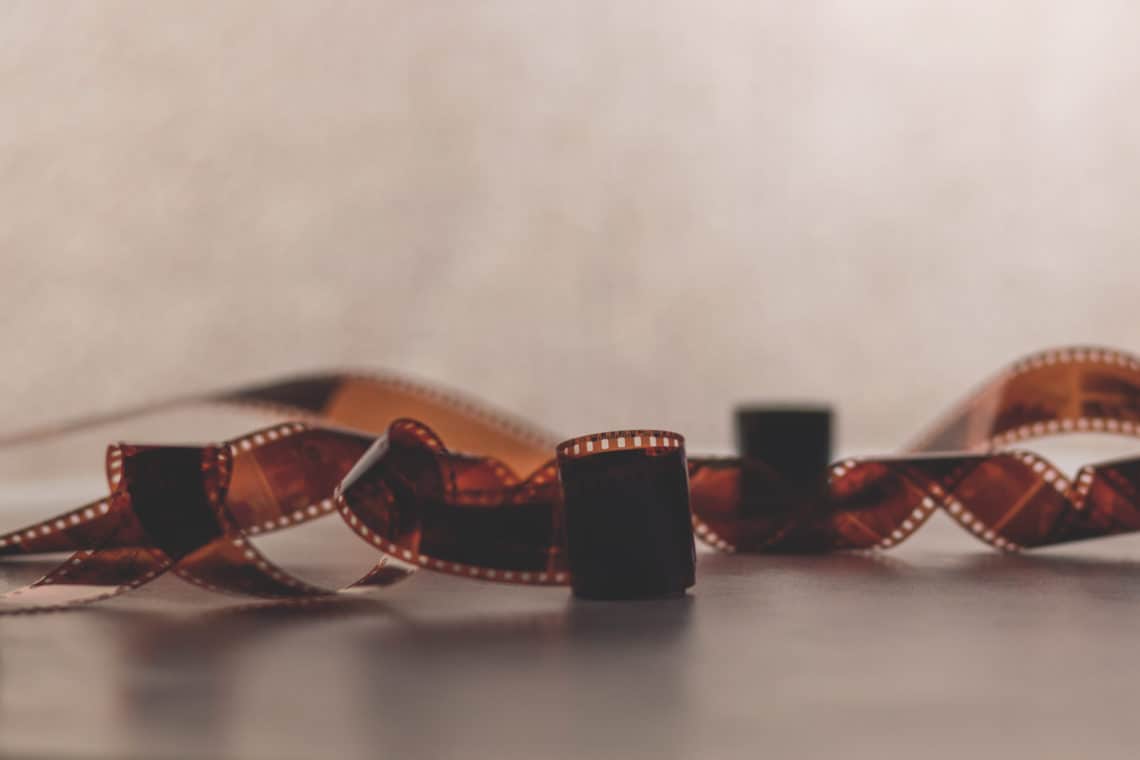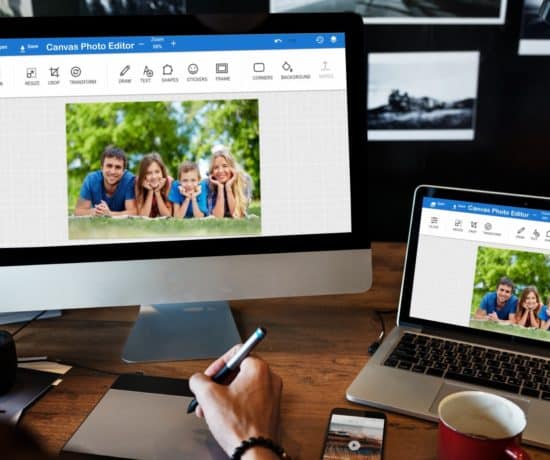Most memorabilia boxes I come across usually contain printed photos, and those prints are almost always stored in the original drugstore envelopes along with the original negatives. How many of those negatives to keep or toss is always a difficult question, but even though I’m in favor of cutting down on clutter overall, I tend to hang on to most negatives. Reason? The original photo is always the best quality available, and if you have that, you can always develop it again. This tends to be a hot topic, so this week Cora Foley from SmoothPhotoScanning.com is sharing her best tips and tricks for storing and handling negatives.
Take it away, Cora…
What Exactly is a Negative?
Negatives are an amazing form of analog media that can contain rich history within them, but they’re very sensitive and require proper care to ensure the treasures within them aren’t lost forever.
A negative is considered the “1st generation” of a visible image. It’s produced when an unexposed, emulsion-coated piece of plastic is moved through a camera to the lens area. This causes the film to be exposed to light, and creates a reaction. The film is then rewound back into an unexposed area of the camera. Once the film is chemically developed, an image will appear, creating the negative you find in your photo collection. Based on the type of camera that was used, you might have differently sized negatives; different types include 35mm, 110 format, 126 format, medium format, and large format.
Nowadays, a negative is typically found on a thin sheet of transparent, plastic film, but originally they were made on paper and subsequently on thin sheets of glass. Although it’s important to note that while a negative is always on a transparent material, just because an image is transparent, it’s not necessarily a negative. In black and white photographs, the lightest colors of the image appear dark in a negative, while the dark areas of the photo appear light. Color negatives appear in the complimentary color version of their photo counterpart.
Should I Keep or Toss My Negatives?
There is a lot of debate as to whether or not you should keep or toss your negatives. They are typically small so it’s hard to see what images they contain with the naked eye. This can make it hard to determine which ones actually contain images you wish to view. That being said, they enable you to create the highest quality versions of your photos. A negative will create a much sharper version of your image than a scanned copy of a photograph could, but with an untrained eye, the difference in the quality might be difficult to spot.
Pros:
- They contain the most image detail – meaning they produce the highest quality prints & digital images.
- Scanning them directly to a digital image increases the clarity and color of an image.
Cons:
- They are typically small, making it hard to tell what images you have.
- They are extremely delicate and easily succumb to damage.
If a negative is the 1st generation of an image, that makes the printed photo the 2nd generation, and your scanned digital image the 3rd generation. In this derivative process, image quality is lost, so the best way to obtain the highest quality digital images is to scan a negative directly to a digital image. If you have unharmed negatives and room to store them, we recommend saving them until you’re able to scan them because if you can produce a higher quality image, why not do so?

I’m a Perfect Pinnable!
Proper Negative Storage
Storing negatives properly is imperative to their safety. Because negatives are so delicate and the film is so thin, they are at a high risk for damage, including elemental damage (moisture, heat, & light), oil damage, scratches and deterioration. They require special storage to ensure their longevity, or they won’t be able to produce a high quality print or digital image. Some damage may even prevent you from retrieving the image at all.
Here are some tips for properly storing your negatives:
Storage Do’s
- When handling your negatives, make sure your hands are clean and dry. Only hold them by the edges (the oils in your hands can damage them).
- Make sure your negatives are free of dust & dirt prior to storing them. If you notice dirt and dust, you can use canned air to blow off any debris.
- Put clean negatives in polyethylene sleeves. This kind of plastic is safe and won’t cause any damage to film.
- Make sure to store negatives flat. We recommend you put them into sleeves and store them in a binder or lay them flat in a plastic box made of polypropylene.
- Store negatives in a cool, dark & dry environment where the temperature doesn’t fluctuate much.
Storage Dont’s
- Make sure you don’t hold the negative anywhere but by the edge. The oils in your hands can cause damage to it, preventing you from extracting the image.
- Don’t stack negatives. Any moisture in the air can cause the sheets of negatives to stick together. This could cause distortion and rips, and even completely destroy the film.
- Make sure your negatives are stored flat. Film easily warps, which causes image distortion and makes it difficult to scan (the film can actually crack and fall apart).
- Don’t store your negatives in the attic or your garage (or where the temperature fluctuates rapidly). This increases the rate of decay.
- Store negatives in a low humidity environment. Moisture can cause the negatives to stick to their surroundings (ruining the images they contain and potentially destroying the whole film).
Take Action Now
Regardless of how you store your negatives, they will inevitably degrade, but it’s best to try and store them as safely as possible so you don’t speed up the degradation process. The sooner you scan them, the better. If you notice your film smelling like vinegar or any warping and wrinkling, the natural degradation process has already begun. The only way to slow down the effects of decay are to store the negatives in a cool, dark place. If you have degraded negatives, it may still be possible to retrieve your images, and if so, you can hire a professional to restore those newly digitized images. If you need help scanning or storing your negatives, we (SmoothPhotoScanning.com) are happy to help you!
Editor’s Note: Thanks for your valuable insight, Cora! My personal process is to organize my clients’ negatives like I would organize their printed photos, meaning in archival sleeves, boxes, or binders, but I’m curious to hear what you do! Drop a note in the comments below to let us know if you toss or keep your negatives, and if so, how you store them!






Art Taylor
December 1, 2016 at 11:05 pmThis post is quite informative. Another advantage to scanning original negatives instead of prints, in addition to those Cora mentioned, is that, except for custom print jobs (done by an amateur photographer in a ‘wet’ darkroom or by a pro photographer or commercial lab where it was more expensive per print than the common machine prints), the entire image area can be scanned, including the edge borders if desired. Most machine prints lose a potentially significant part of the image on each edge. Curtis Bisel, in his blog “Scan Your Entire Life”, posted an article about his experiences scanning both the negative and a machine print made from it. For color negatives, unless one pays extra for a custom print job, the color balance and exposure are the result of whatever the automatic settings on the machine printer are set at to give “correct” color balance and exposure . Those glorious saturated reds, oranges, and yellows of a sunset against a jet black foreground silhouette that you saw and thought you had captured on film will likely be totally washed out since the machine tried to compensate for what it saw as an underexposed foreground. A decent scan, done either by a commercial company, or by an individual at home, can be adjusted to give the intended color balance and exposure from the negative. A scan from a print can never recover the same color balance and exposure of the negative.
Cora didn’t mention the most recent generation of film negatives, the APS (Advanced Photo System) negatives which appeared in the late 1980 or early 1990s. They came in a plastic cartridge, were pulled through the camera for exposure, then rewound into the same cartridge for processing. The lab returned the negatives, still on the same roll, in the same cartridge, along with a set of prints. The format never really became very popular because the image size was somewhat smaller than the more common 35 mm (24 mm x 36 mm) and the inexpensive cameras and lenses lacked the same quality of sharpness as other format cameras and lenses. There are some commercial scanning companies who will scan APS films, but because they require special equipment and handling, prices for such scans tend to be higher than for more common formats. Another format not mentioned is the ‘Disc’ format introduced by Kodak but also supported by Fuji. The Disc cameras used a circular disc which held a number of small negatives, similar in appearance to the View Master reels which were common in the 1950s and 1960s. Because of the very small image size, about the same size as the 110 Pocket Instamatic size (unlike Kodak’s early 1900s original 110 format film), and the cheap lenses on the cameras, image sharpness was severely lacking and this format also never really became popular. There are articles and a few Youtube videos about scanning both APS and Disc negatives yourself, usually with a flatbed scanner with a transparency adapter unit, such as some of the Epson flatbeds.
While glass is mentioned as a material for early negatives, there is little more information in the post about glass negatives. I’m interested in knowing more about the proper storage for my glass negatives of various sizes, ranging from about 2″ x 3″ up to 8″ x 10″, with various sizes in between. There are currently a few flatbed scanners available to scan medium to large format negatives but they tend to be quite expensive. I’ve had reasonable success using an Epson V-600 and scanning glass negatives as reflective originals, then inverting the Levels and Curves in an image editor to achieve the desired positive image.
Caroline Guntur
December 2, 2016 at 9:04 amThanks for your input, Art! You’re right that there are some clear advantages to scanning negatives in favor of prints, and I think that’s a great point to bring up! We can certainly look into writing something about glass negatives and how to properly store them because most of us will come across that! Thanks for the suggestion!
Art Taylor
December 1, 2016 at 11:12 pmOne other point to raise about early flexible, film negatives: the first flexible film negatives used a nitrate base instead of the later acetate base of “Safety Film”. If you have film negatives that don’t say “Safety Film” in the clear rebate (the strip of plastic near the sprocket holes, get those negatives scanned as soon as possible, then contact your local fire department to learn how to safely dispose of those nitrate-based negatives. They do deteriorate over time, regardless of how they are stored and can spontaneously burst into flame. Get them digitized for archival purposes and later reproduction as desired but then dispose of them safely before they cause a serious fire.
Caroline Guntur
December 2, 2016 at 9:07 amAnother great point! I have a blog post coming up about recycling media properly, and I’ll be sure to include that information! I think the challenge is for people to notice the difference, but your suggestion about where to look for the clues will help a lot!
Jana Last
December 2, 2016 at 4:24 pmHi,
I want to let you know that your blog post is listed in today’s Fab Finds post at http://janasgenealogyandfamilyhistory.blogspot.com/2016/12/follow-friday-fab-finds-for-december-2.html
Have a great weekend!
Caroline Guntur
December 2, 2016 at 5:36 pmThanks Jana! I’m honored that we’re included!
Cynthia DiBuglione
September 13, 2017 at 1:59 pmHello! I have some large (25″ X 30″) acetate negatives that are quite valuable, and I need to make sure they’re stored correctly and preserved. Any recommendations?
Caroline Guntur
September 18, 2017 at 9:37 amHi Cynthia,
Get some archival storage supplies specifically for negatives, either from Archival Methods (archivalmethods.com) or from Gaylord Archival (gaylord.com). Stored the flat if you have the space available, out of the way of heat and humidity.
Peter
December 22, 2017 at 10:48 pmCaroline, do you know of any suppliers in EU?
Caroline Guntur
January 4, 2018 at 6:42 amYes, there are a few, but you’d have to check their current shipping/delivery guidelines to your location specifically as I haven’t done that in recent years. You can try Gresswell (http://www.gresswell.co.uk/), CR Conservation Resources (http://www.conservation-resources.co.uk/), or CTS (http://www.ctseurope.com/en/). Pretty sure Gresswell will ship to Denmark if you ask nicely. 🙂
nicholas
November 17, 2017 at 12:01 amI am curious about why some sleeving is frosted and some is clear. IS there a reason one would choose a clear vs frosted sleeve to store a slide in?
~nicholas
Caroline Guntur
November 18, 2017 at 12:23 pmHi Nicholas! The type of plastic you choose has to do with the clarity and the way it’s manufactured. Frosted sleeves have less slip agents, which may be more suitable for slides and negatives to keep them in place and protect against light, etc. while the clear ones are better suited for articles and photos that you may want to look at every now and then. I don’t know that there is a significant difference in the quality and safety of using either type though. Glassine sleeves, however, are less appropriate in my mind because they tend to stick after a few years. They’re the ones that look like wax paper. Hope that helps! Archival Methods has a great video that explains some of their materials here: http://video.archivalmethods.com/2fefe70d12c8600d/video/custom/mp4/2878-1322.mp4